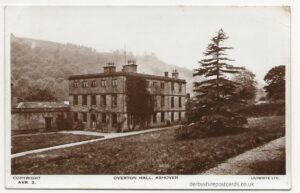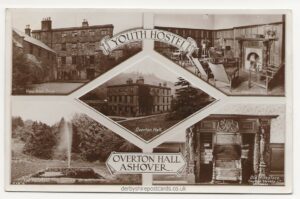Overton Hall was the country house of Sir Joseph Banks., the naturalist, who collected thousands of plant specimens previously unknown in Europe on his voyage to the Pacific with James Cook on the Endeavour.
It is a large rectangular house remodelled in 1693-99 (datestones) around a substantial Smythsonesque tower house.
The Hall is Grade II listed building. Mid- to late-17th century, with extensive remodelling with additions in 1702, 1788 and 1900, and with further 20th century alterations when the building was turned into a nursing home.
The original house was the seat of William le Hunte in 1323 whose descendants sold in 1556 to Richard Hodgkinson of Northedge Hall, also in Ashover. It passed through several further families before coming to Banks, who much improved the house and grounds and developed the mineral resources of the estate. Following his death in 1820, it again had a succession of owners, including the Clay Cross company. It also served for a time as a Youth Hostel and later as a home for the elderly. From 1990 it stood empty and at risk. It was purchased in 1997 but by 2001 was for sale again, in a poor state and in need of restoration.
from Picture The Past
In 1220 a family named Le Hunt were owners of Overton, where they continued to reside until 1556, when Thos Hunt sold the Hall and the estate to Richard Hodgkinson. An heiress of the Hodgkinsons married a Banks, of Revesby Abbey, and this family owned Overton for three generations (including Sir Joseph Banks the celebrated naturalist and President of the Royal Society). The estate then passed to Sir E Knatchbull, of whom it was purchased by John Bright, MD, and William Milnes of Stubben Edge. Later it was purchased by William Jessop of Butterley Hall and passed to his son William de Burgh Jessop. The Clay Cross Company bought the Overton Hall estate in 1918. They had no need of the Hall, but the grounds, of approximately 1000 acres, contained fluorspar, barytes and limestone. In order to transport these products, from the quarries at Ashover to their works at Clay Cross, the Ashover Light Railway was built. The railway ran immediately in front of the cottages on the Overton Hall estate, which were tenanted by workers of the Clay Cross Company. The hall was loaned to the YHA from 1933-39 and again from 1950-56, by the Clay Cross Company.
from Childrens Homes
On February 16th, 1942, the Overton School fro Boys was formally certified to operate as an Approved School in premises at Gin Lane, Ashover, near Chesterfield. The School could accommodate up to 50 junior boys aged below their 13th birthday at the time of admission.
On 5th February, 1948, the managers of the School announced their intention to resign its certificate and close the establishment.
From 1950 to 1956, the property was used as a youth hostel. then later operated as Overton Hall Old People’s Home.



